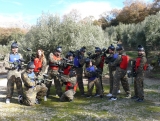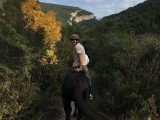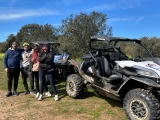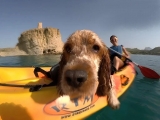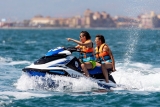Rosa Fernández is an Asturian mountaineer who has dedicated her entire life to adventure sports, particularly those where personal achievement is paramount, such as rock climbing. Through this sport, she has conquered Everest and completed the "Seven Summits" project, scaling the seven highest peaks in the world.
But she doesn’t neglect other pursuits like mountain biking, which enabled her to traverse the Himalayas and overcome a personal challenge. She has written two books and still dreams of new adventures, now that she has been given the all-clear by her doctors and is planning a return to the Himalayas. We wish her the best of luck in her next adventure.

Yumping.- Born and bred in Asturias, you grew up surrounded by mountains. Tell us, when did you start mountaineering?
Rosa Fernández.- Yes, I was born in a small mountain village. I started mountaineering with my husband and friends. My first climbs were in the Picos de Europa in the 1980s.
Y.- Once you decided to dedicate yourself to mountain sports, did you receive support from your loved ones?
R.F.- Yes, I’ve always had their support, though they’ve never been particularly keen on it.
Y.- How did your training begin?
R.F.- I’d always done sports as a hobby, but I started dedicating more hours to the mountains and focused on improving my physical condition to endure long treks over consecutive days.
Y.- In 1997, you undertook your first expedition to the Himalayas. Do you remember how it was planned?
R.F.- I remember there were seven guys, and they wanted to include a woman in the group to make it easier to secure sponsors. Interestingly, they first approached my husband, who thought it was a good idea, and then they invited me to join. I’d climbed the Matterhorn in '96, which had given me some recognition. Some of them had already been to the Himalayas.
Everything was very natural, spontaneous, and full of doubts; it took us months to organise and complete the preparations. It was all so new to me and so rewarding that I became fascinated by the great mountains. Everything went very well.

Y.- Once you reached the summit, what was the first thing that crossed your mind?
R.F.- I was happy and calm, the landscape was incredible, with a sunny day and a deep blue sky. I felt so good that I didn’t want to come down. I thought that experience would repeat itself, and the sooner, the better. Back then, communications weren’t like today, and it took ten days before we could share our success with our families, who had no news from us for weeks.
Y.- You’ve travelled to different places and climbed countless mountains: Gasherbrum II, Shisha Pagma, Dhaulagiri, Everest... Which place surprised you the most?
R.F.- The Himalayas are incomparable to any other place, and Everest is the mountain that has it all: the most complete, the most beautiful (at least to me), and though I expected all that, it didn’t disappoint me at all.
But all mountains are beautiful and have their own personality. Perhaps the one that surprised me most was the Carstensz Pyramid in Papua New Guinea. Stunning and remote; after a journey to the other side of the world, I found a place with features very similar to our Picos de Europa, but over twice as high—an incredible place, though its inaccessibility makes it nearly impossible for most climbers.
Y.- As a mountaineer, why did you decide to cross the Himalayas by bike?
R.F.- My husband, who not only got me hooked on mountains but also introduced me to mountain biking—we also own a bike shop—had information about cycling from Lhasa to Kathmandu and seeing Everest’s north face. He promoted that adventure in 2002, and in the end, I was the one who did it. I wanted to see Everest and had been looking for years for a way to climb it; I finally did so in 2003. I repeated the bike journey again in 2007.
Y.- The "Seven Summits" challenge was a major milestone in your career. How did the idea come about?
R.F.- In 2005, I summited Everest and was in a favourable position to secure funding, as the Seven Summits require a huge financial outlay in a short time. My advantage was that I went alone, so expenses were for just one person. Even so, when the time came to go to Antarctica, my entire effort nearly collapsed because I didn’t have enough budget to cover the costs.
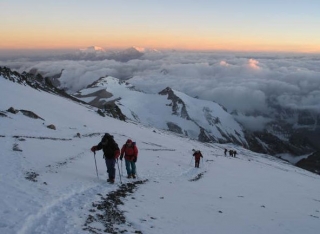
I finally did it. I climbed all seven mountains in less than two years, handling everything myself, even booking flights and planning each trip step by step. For me, reaching the foot of each mountain was a great joy because from there, it was all up to me; the stressful part was getting from Asturias to each destination.
Y.- What kind of training is needed to meet such challenges?
R.F.- You need constant, rigorous training to build physical endurance and prepare for any weather conditions—walking and climbing day or night, in cold, storms, snow... You have to adapt to everything. Above all, you need mental training: patience, waiting for the right conditions, knowing not to take unnecessary risks, and covering your back.
The more time passes, the more I realise mental strength is the most essential quality. I’ve seen strong climbers, as fit as the best athletes, lose their nerve and retreat, defeated, sometimes almost without a fight.
Y.- Nowadays, what’s a typical day like for an athlete like you?
R.F.- Aerobic training in the morning, mostly cycling. Gym in the afternoon to strengthen specific areas, stretching, and recovery. I also have a knee injury that prevents me from running, and I need to improve it for my next expedition, but I’m not too worried—after months of work, it’s getting better.

Y.- In 2009, you underwent breast cancer surgery. Yet you still attempted Broad Peak (8,046m). Was this the toughest challenge of your life?
R.F.- It was a CHALLENGE in capital letters. The summit wasn’t the main goal; it was about testing myself, seeing if my mental strength was intact and if my physical strength, though diminished, could still rise to the occasion. It was a unique experience—the doctors calculated the right time for a two-month break in my treatment, which I resumed on my return.
It turned out to be a year of extremely harsh weather in the Karakoram. I didn’t summit, but I didn’t feel defeated by myself—rather, by the mountain. I think no one summited that season. Tragically, an Italian climber I shared a permit with died in a fall during the ascent, shortly after I abandoned my attempt.
Y.- What would you say to others who, like you, have suffered or are suffering from this illness?
R.F.- It’s something that concerns me, and I want to do something for them. I’ve seen many people suffering in hospital, and often their mental attitude is as bad as their physical pain. You can’t let the illness win; you must fight with all your strength. Everyone must fight within themselves and believe victory is possible. VICTORY IS POSSIBLE.

It’s not just about medication—our brain is a weapon with far more power than we imagine. Here, I have an advantage because in extreme high-altitude situations, my brain is better trained to face difficulties. So my message is this: put your mind to work and never give up, not even for a moment. You must never doubt that you’ll pull through.
Y.- We also know you’ve written two books. What’s your next challenge?
R.F.- My first book is .
I want to return to the Himalayas in 2011 and keep doing things by bike.
Y.- Where do you see yourself in ten years?
R.F.- I see myself as I am now—with a heap of projects and too little time to tackle all the pending tasks.





